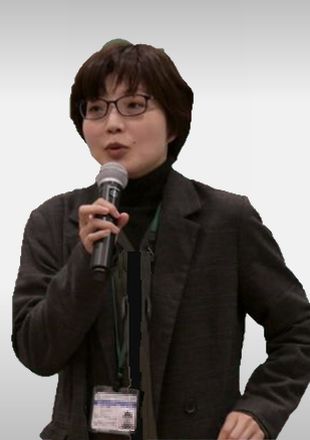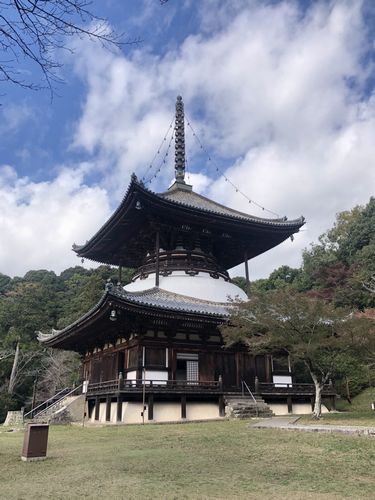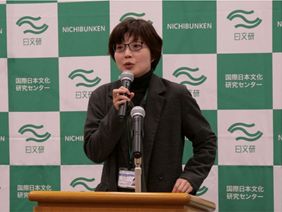Interview with Liberal Arts Communicator Guo Jianing

The National Institutes for the Humanities (NIHU) has been conducting research on human cultures from diverse angles to understand how individuals as well as nature and humans can harmoniously coexist with each other. To that end, we believe it is critical to facilitate communication between the researchers at the forefront of research and society.
As part of this effort to enhance such communication, NIHU holds various events for the general public and also provides training programs for liberal arts communicators who facilitate and engage in “two-way communication” between experts and non-experts. Who are these “liberal arts communicators?” What kinds of activities do they engage in? We will answer those questions in a series of articles.
The 10th article in this series is about Dr. Guo Jianing at the International Research Center for Japanese Studies (Nichibunken). Dr. Guo took on her new position as Liberal Arts Communicator at Nichibunken in October 2022. In this interview, we asked her about her research and work at Nichibunken.
Could you please tell us about your encounter with your research topic?
I majored in Japanese at my university in China, but I had an interest in Buddhism and was reading books about it just to satisfy my curiosity around the time I had to choose my thesis topic. Eventually, I resolved to study structures and other physical manifestations of Buddhism as I was more drawn to them than to its philosophy.
On my first visit to Japan, I became fascinated by the Konpon Daitō, the massive stūpa located at Mt. Koya. That trip inspired me to approach Buddhist studies from the perspective of architecture and to explore how this religion is represented in such sacred spaces and buildings as stūpas. I ended up coming to Japan to study esoteric Buddhism, because, while the tradition originated in Tang China (618–907) from which Kūkai (774−835) brought the teachings to Japan, it gradually declined in China after the Tang Dynasty but has remained influential in Japan. For the first six months of my study, I trained as an undergraduate research student under a supervisor, after which I was admitted to a master’s degree course and went on to receive my doctoral degree.

The Negoro-ji temple Daitō, Japan’s national treasure. Photo by Jianing Guo, in [2020.11.22].
Would you outline your research?
I study Exo-exoteric Buddhism(kenmitsu bukkyō)of medieval Japan from the perspectives of religious literature and intellectual history. The three pillars of my research are
(1) the meaning and influence of the practical activities of religious figures;
(2) the nature of teaching and belief that takes place in or is manifested in religious spaces;
(3) the establishment and development of religious discourse.
My core research topic is the goganji temples that were established by emperors, empresses, or princes during the Insei period, and, regarding this theme, I am particularly interested in the Daidenpо-in at Mt. Kоya, which Shingon monk Kakuban (1095−1143; posthumously known as Kōgyō Daishi), founded for Emperor Toba (1103−1156); Kakuban’s esoteric thought and religious practice; and Raiyu (1226–1304), a learned Shingon monk who inherited Kakuban’s teachings.
How did the COVID-19 pandemic influence your research?
My research and study centers around Buddhist scriptures archived in temples, so for a while, the pandemic prevented me from examining materials at temples and libraries. The National Diet Library, for instance, temporarily adopted a lottery-based reservation system to limit visitors.
My research also requires studying the types of Buddhist services conducted by temples. Some of these rituals were unfortunately canceled because of the health crisis, but they are gradually restarting. I would add that some temples now stream memorial services and other events on YouTube because of the COVID-19 pandemic, making it easier for me to observe such ceremonies.
Please tell us what inspired you to become a Liberal Arts Communicator.
My research is fundamentally about examining the culture of Buddhism through religious spaces. As my studies progressed, I began to sometimes wonder how research endeavors that elucidate religious culture and thought relate to today’s people and society, and about the social significance of research activities. I found myself wanting to do more to introduce my research area to a wider range of people and better articulate the role and meaning of the humanities today, including my own research. That’s when I learned about the liberal arts communicator research position, and it perfectly matched what I was hoping to do.
How is Nichibunken involved in your research and what are some of your activities, for example in public relations, etc.?
In the coming academic year, I am officially joining Nichibunken Professor Araki Hiroshi’s team research project “Solid ‘Impermanence’/Fragile ‘Impermanence’: The Transmogrification of the Classics and Future Prospects.” I hope to engage in this collaboration by examining the Buddhist concept of transience (mujō) from the perspective of religious rituals using a methodology called shūkyō tekusuto gaku (lit., religious text studies)—which focuses on scriptures, icons, and religious rituals performed at temples—and the functions of religious spaces in changes and views of the future seen in the world of the Japanese classics.
On the public relations front, I participated in Nichibunken’s media roundtable in November and shared my research activities among other topics. The Center hosts these sessions around four times a year. In the coming academic year, I also will be in charge of workshops for the children of the Kyoto City Katsurazaka Elementary School, located near Nichibunken. I create and publish online articles as well, called Jin-komyu tsūshin [short for “Liberal Arts Communicator News”], in which I interview Nichibunken professors and share their research, the Center’s activities, and other information. I took over the series from my predecessor Dr. Mitsuhira Yūki, who originally launched it. I will also be in charge of creating promotional materials and write for PR magazines as well to work to attract interest in Nichibunken and the humanities from the general public.
How do you want to approach the role of a Liberal Arts Communicator from here on?
My basic job is to gather information about Nichibunken’s archival resources and research activities. Today, one needs to actively use digital technology to handle public relations tasks. I will thus endeavor to find new value in the humanities while working for the integration of physical and digital resources, and further explain the significance of humanities research to the public. One example is to capture the attention of a larger group of people by harnessing augmented and virtual reality technology, so that guests visiting Nichibunken collection exhibitions can have an enjoyable, hands-on experience. I also hope to contribute to further enhancing the uses of and enrichment of the information stored in Nichibunken’s databases, and commit to collaborating with professors to create digital content.
Given that mid-career scholars are working energetically for the development of the humanities, the next step is to incorporate the opinions of younger researchers and current graduate students who may eventually become scholars. I intend to accommodate and reflect the voices of young academics in research promotion and PR activities from here on.
(Interviewer: OHBA Go, Researcher, Center for Innovative Research, National Institutes for the Humanities)
Guo Jianing
Specially Appointed Assistant Professor, International Research Center for Japanese Studies
Guo Jianing obtained a doctoral degree in literature from the Nagoya University Graduate School of Letters in 2019. After serving as a research fellow at the Research Center for Cultural Heritage and Texts affiliated with Nagoya University Graduate School of Humanities from 2021, she assumed her present position in October 2022. Her research interests include the religious literature of medieval Japan.

